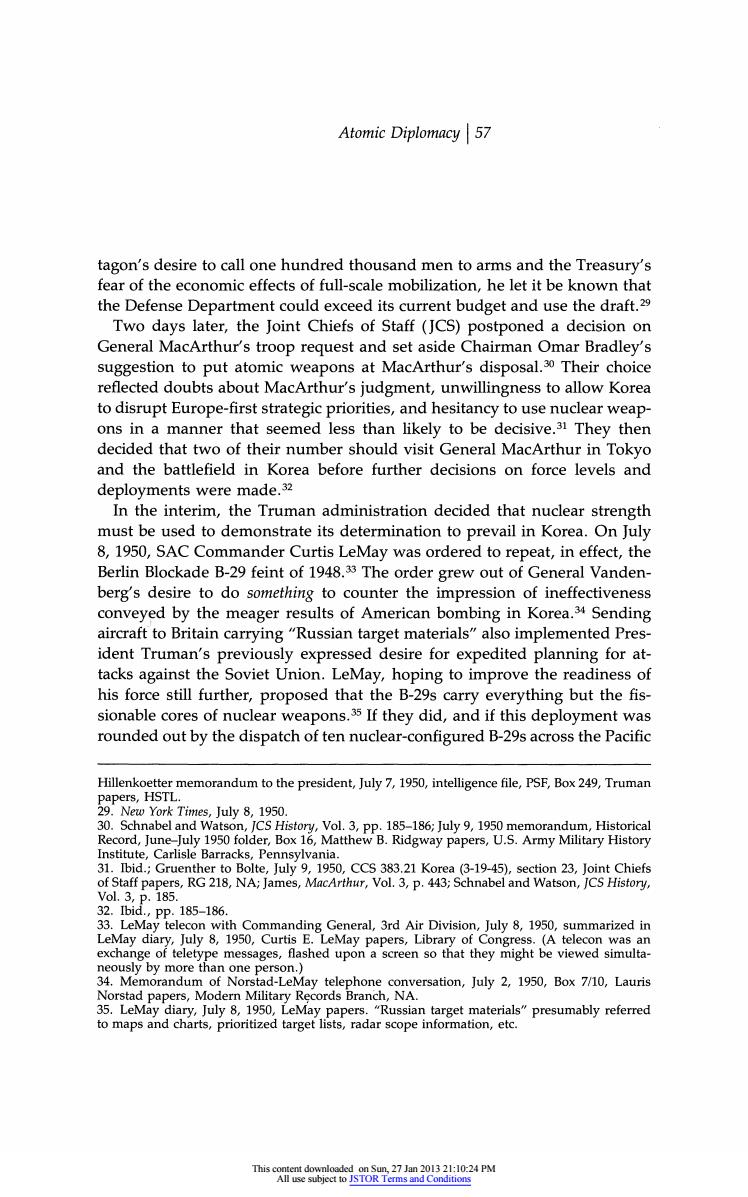正在加载图片...

Atomic Diplomacy 57 tagon's desire to call one hundred thousand men to arms and the Treasury's fear of the economic effects of full-scale mobilization,he let it be known that the Defense Department could exceed its current budget and use the draft.29 Two days later,the Joint Chiefs of Staff(JCS)postponed a decision on General MacArthur's troop request and set aside Chairman Omar Bradley's suggestion to put atomic weapons at MacArthur's disposal.30 Their choice reflected doubts about MacArthur's judgment,unwillingness to allow Korea to disrupt Europe-first strategic priorities,and hesitancy to use nuclear weap- ons in a manner that seemed less than likely to be decisive.31 They then decided that two of their number should visit General MacArthur in Tokyo and the battlefield in Korea before further decisions on force levels and deployments were made.32 In the interim,the Truman administration decided that nuclear strength must be used to demonstrate its determination to prevail in Korea.On July 8,1950,SAC Commander Curtis LeMay was ordered to repeat,in effect,the Berlin Blockade B-29 feint of 1948.33 The order grew out of General Vanden- berg's desire to do something to counter the impression of ineffectiveness conveyed by the meager results of American bombing in Korea.3 Sending aircraft to Britain carrying "Russian target materials"also implemented Pres- ident Truman's previously expressed desire for expedited planning for at- tacks against the Soviet Union.LeMay,hoping to improve the readiness of his force still further,proposed that the B-29s carry everything but the fis- sionable cores of nuclear weapons.35 If they did,and if this deployment was rounded out by the dispatch of ten nuclear-configured B-29s across the Pacific Hillenkoetter memorandum to the president,July 7,1950,intelligence file,PSF,Box 249,Truman papers,HSTL. 29.New York Times,July 8,1950. 30.Schnabel and Watson,JCS History,Vol.3,pp.185-186;July 9,1950 memorandum,Historical Record,June-July 1950 folder,Box 16,Matthew B.Ridgway papers,U.S.Army Military History Institute,Carlisle Barracks,Pennsylvania. 31.Ibid.;Gruenther to Bolte,July 9,1950,CCS 383.21 Korea (3-19-45),section 23,Joint Chiefs of Staff papers,RG 218,NA;James,MacArthur,Vol.3,p.443;Schnabel and Watson,JCS History, Vol.3,p.185. 32.Ibid.,Pp.185-186. 33.LeMay telecon with Commanding General,3rd Air Division,July 8,1950,summarized in LeMay diary,July 8,1950,Curtis E.LeMay papers,Library of Congress.(A telecon was an exchange of teletype messages,flashed upon a screen so that they might be viewed simulta- neously by more than one person. 34.Memorandum of Norstad-LeMay telephone conversation,July 2,1950,Box 7/10,Lauris Norstad papers,Modern Military Records Branch,NA. 35.LeMay diary,July 8,1950,LeMay papers."Russian target materials"presumably referred to maps and charts,prioritized target lists,radar scope information,etc. This content downloaded on Sun,27 Jan 2013 21:10:24 PM All use subject to JSTOR Terms and ConditionsAtomic Diplomacy |57 tagon's desire to call one hundred thousand men to arms and the Treasury's fear of the economic effects of full-scale mobilization, he let it be known that the Defense Department could exceed its current budget and use the draft.29 Two days later, the Joint Chiefs of Staff (JCS) postponed a decision on General MacArthur's troop request and set aside Chairman Omar Bradley's suggestion to put atomic weapons at MacArthur's disposal.30 Their choice reflected doubts about MacArthur's judgment, unwillingness to allow Korea to disrupt Europe-first strategic priorities, and hesitancy to use nuclear weapons in a manner that seemed less than likely to be decisive.31 They then decided that two of their number should visit General MacArthur in Tokyo and the battlefield in Korea before further decisions on force levels and deployments were made.32 In the interim, the Truman administration decided that nuclear strength must be used to demonstrate its determination to prevail in Korea. On July 8, 1950, SAC Commander Curtis LeMay was ordered to repeat, in effect, the Berlin Blockade B-29 feint of 1948.33 The order grew out of General Vandenberg's desire to do something to counter the impression of ineffectiveness conveyed by the meager results of American bombing in Korea.34 Sending aircraft-o Britain carrying "Russian target materials" also implemented President Truman's previously expressed desire for expedited planning for attacks against the Soviet Union. LeMay, hoping to improve the readiness of his force still further, proposed that the B-29s carry everything but the fissionable cores of nuclear weapons.35 If they did, and if this deployment was rounded out by the dispatch of ten nuclear-configured B-29s across the Pacific Hillenkoetter memorandum to the president, July 7, 1950, intelligence file, PSF, Box 249, Truman papers, HSTL. 29. New York Times, July 8, 1950. 30. Schnabel and Watson, JCS History, Vol. 3, pp. 185-186; July 9, 1950 memorandum, Historical Record, June-July 1950 folder, Box 16, Matthew B. Ridgway papers, U.S. Army Military History Institute, Carlisle Barracks, Pennsylvania. 31. Ibid.; Gruenther to Bolte, July 9, 1950, CCS 383.21 Korea (3-19-45), section 23, Joint Chiefs of Staff papers, RG 218, NA; James, MacArthur, Vol. 3, p. 443; Schnabel and Watson, JCS History, Vol. 3, p. 185. 32. Ibid., pp. 185-186. 33. LeMay telecon with Commanding General, 3rd Air Division, July 8, 1950, summarized in LeMay diary, July 8, 1950, Curtis E. LeMay papers, Library of Congress. (A telecon was an exchange of teletype messages, flashed upon a screen so that they might be viewed simultaneously by more than one person.) 34. Memorandum of Norstad-LeMay telephone conversation, July 2, 1950, Box 7/10, Lauris Norstad papers, Modern Military Records Branch, NA. 35. LeMay diary, July 8, 1950, LeMay papers. "Russian target materials" presumably referred to maps and charts, prioritized target lists, radar scope information, etc. This content downloaded on Sun, 27 Jan 2013 21:10:24 PM All use subject to JSTOR Terms and Conditions